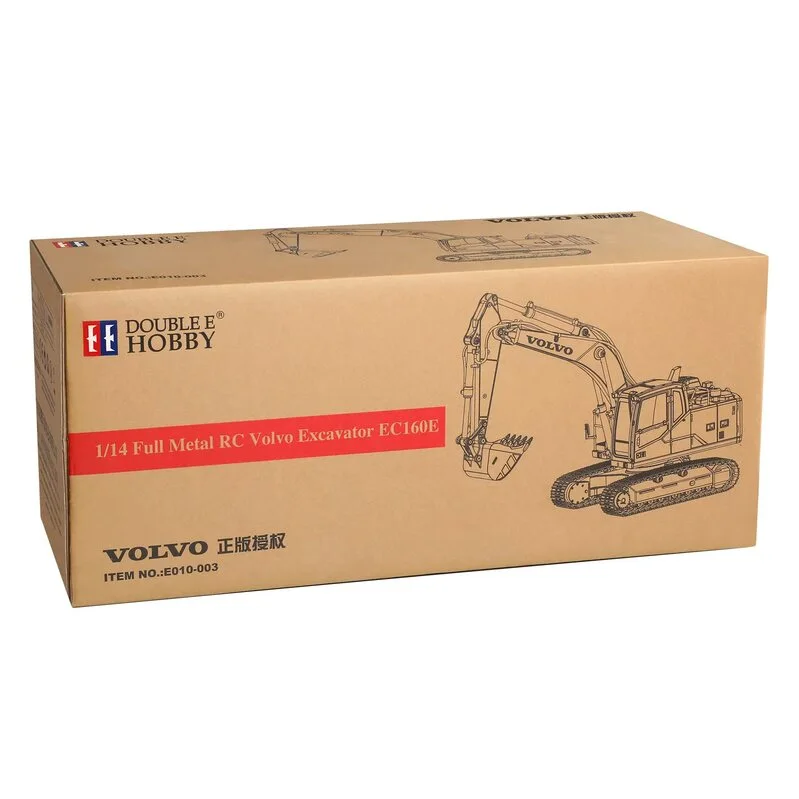Can a rc excavator Save You Time and Money? Here’s How
Wiki Article
The Necessary Features of Excavator That Keep It a Must-Have Tool
Excavators are indispensable in the building and construction and landscape design industries. Their flexible add-ons enable a range of tasks, from excavating to demolition. In addition, they boast premium digging depth and reach, powered by robust engines. Driver convenience and portable styles boost functionality in different settings. Nevertheless, what genuinely sets excavators apart are their innovative hydraulic systems and sturdiness. Comprehending these functions can clarify why they are thought about crucial tools on any kind of task website.Versatile Accessories for Boosted Functionality
Although excavators are powerful equipments by themselves, the addition of flexible attachments greatly boosts their performance. These add-ons transform a common excavator into a multi-purpose tool, suitable for a variety of tasks. Pails, as an example, can be found in different sizes and shapes, making it possible for operators to dig, scoop, and move products successfully. Hydraulic thumbs can be included for boosted gripping and handling of large products, such as logs or rocks.Furthermore, specialized accessories like augers and breakers permit drilling and demolition work, broadening the excavator's energy on building and construction sites. remote control excavator. Grapples are another choice, ideal for arranging and moving particles. This adaptability not just enhances efficiency yet likewise reduces the requirement for several machines, conserving time and costs. By gearing up excavators with the best attachments, drivers can take on varied tasks, making them essential in the building marketSuperior Excavating Deepness and Get To
Excavators are designed with exceptional excavating depth and reach, allowing them to navigate in limited rooms and gain access to hard-to-reach locations. This ability is critical for numerous construction and excavation jobs, where conventional machinery might fail. With flexible boom arms and extendable tracks, excavators can quickly browse unequal surface while keeping stability.The excavating depth can vary substantially among designs, commonly ranging from 10 to 25 feet, relying on the design and purpose. This attribute allows drivers to dig deep into structures, trenches, and other deep structures successfully. In addition, the reach of an excavator permits precise digging and material handling without repositioning the device regularly, saving time and labor costs.Ultimately, the superior digging depth and reach of excavators make them crucial for professionals looking for to complete complex tasks with accuracy and effectiveness. Their convenience enhances productivity on job websites, showcasing them as a vital device in modern building and construction.Powerful Engine Efficiency

When it involves performance and productivity on building websites, effective engine performance plays a crucial duty in the capacities of an excavator. A robust engine produces considerable horsepower, allowing the maker to deal with sturdy tasks effortlessly - remote control excavator. This toughness translates into faster cycle times, allowing drivers to complete tasks extra quickly.Additionally, powerful engines supply the needed torque to manage tough surfaces and varied tons, making sure that the excavator can perform efficiently under different problems. Whether it is lifting, excavating, or moving materials, the engine's efficiency straight affects the total functional performance of the machine.Furthermore, advancements in engine innovation have actually resulted in enhanced gas efficiency, reducing functional costs while keeping power outcome. Eventually, the engine's efficiency offers as the backbone of an excavator, affirming its status as an essential device in the construction industry
Advanced Hydraulic Equipments

Improved Raising Capability
A significant enhancement in raising ability can be credited to sophisticated hydraulic systems found in modern-day excavators. These systems make use of high-pressure fluid to generate better pressure, enabling operators to raise much heavier lots with convenience. The engineering behind these hydraulics warranties peak performance, giving an excellent power-to-weight proportion that enhances total efficiency. Because of this, excavators can tackle demanding tasks, such as lifting large materials or tools, without jeopardizing security. Furthermore, the durable style of hydraulic components adds to enhanced durability and integrity, making them suitable for numerous building environments. This boosted training capacity not just reduces the time required for projects yet likewise minimizes the requirement for extra machinery, showing vital for both performance and cost-effectiveness in the construction sector.Boosted Precision Control
Traditional excavators usually struggled with precision, contemporary hydraulic systems have changed control devices, enabling operators to carry out tasks with impressive precision. These sophisticated systems utilize symmetrical control shutoffs that allow for smoother and more receptive activities, substantially decreasing the margin for error. Operators can now carefully tune the excavator's motions, making it much easier to browse tight areas and handle delicate materials. Improved feedback systems further educate drivers of real-time performance, making certain optimal control between the equipment and driver. This raised precision not only boosts efficiency yet also improves safety and security on task sites, minimizing the danger of mishaps. Because of this, modern excavators geared up with advanced hydraulic systems are invaluable devices for construction and excavation projects calling for thorough precision.Operator Convenience and Visibility
Driver comfort and exposure are essential components in the style of modern-day excavators (remote control excavator). Features such as ergonomic seat layout, enhanced exposure options, and efficient control formats substantially boost the operator's experience and performance. Prioritizing these aspects guarantees that operators can function successfully and safely in various problemsErgonomic Seat Layout
Comfort and visibility are paramount in excavator design, with the ergonomic seat playing an important duty in improving the driver's experience. An ergonomic seat is engineered to sustain the operator's body, decreasing tiredness throughout long hours of operation. Flexible attributes, such as seat height, back-rest angle, and lumbar support, accommodate specific preferences and advertise suitable stance. These changes improve convenience and allow the driver to maintain emphasis on jobs without discomfort. Additionally, a properly designed seat can provide far better side assistance, allowing for smoother handling when the excavator functions. This thoughtful design not only increases performance but also contributes to total security, making certain that drivers can execute their duties efficiently and effectively.Boosted Visibility Features
The layout of an excavator prolongs past just the seat, with boosted exposure attributes playing a significant function in operator convenience and overall safety. Large home windows and strategically located mirrors supply drivers with a clear view of their environments, lessening dead spots. This style consideration enables much better spatial awareness, which is necessary in active job settings. On top of that, numerous excavators include rearview cameras and progressed tracking systems that aid operators in maneuvering tight areas. The combination of these presence includes not only advertises safety and security however additionally reduces operator exhaustion by making it possible for less complicated tracking of job locations. Inevitably, boosted presence adds to much more effective operations and aids assure that excavators can perform their jobs effectively and securely.Control Format Efficiency
While maneuvering facility work websites, a reliable control layout significantly enhances both driver comfort and visibility. A well-designed control configuration guarantees that operators can access important functions with minimal initiative, minimizing fatigue during long hours. Ergonomic joystick positionings and intuitive switch setups allow for smooth procedure, making it possible for operators to keep concentrate on the task handy. In addition, clear presence of both the workplace and the remote control excavator control panel is crucial for security and precision. Modern excavators usually include adjustable seating and control setups to accommodate different driver preferences, better enhancing convenience. Inevitably, a thoughtfully created control design not just enhances performance yet additionally promotes a much safer working atmosphere by enabling operators to react promptly to altering problems.Compact Design for Urban Environments
As city building and construction sites frequently face space restrictions, a small layout becomes necessary for excavators running in these settings. These makers are engineered to navigate limited spaces, permitting effective ability to move in congested task websites. A minimized impact enables them to work very closely to existing structures, decreasing disruption and optimizing productivity.The portable layout frequently includes much shorter tracks and a tighter turning span, assisting in operation in narrow alleys and restricted areas. Lightweight products add to ease of transport, making it easier to relocate the excavator from one area to another within the metropolitan landscape.Additionally, several small excavators are geared up with attributes such as versatile attachments and extendable arms, improving their capability while keeping a little dimension. This flexibility permits operators to deal with a selection of tasks, from digging to demolition, all while fitting seamlessly right into the constraints of urban settings.
Longevity and Maintenance Considerations
Sturdiness stands as an essential consider the efficiency and durability of excavators, especially popular metropolitan settings. These makers undergo rigorous problems, consisting of varying soil kinds, extreme temperatures, and high-frequency usage. Premium products and durable building and construction are essential for making sure that excavators can withstand these challenges without endangering functionality.Regular upkeep is just as important in preserving longevity. Arranged evaluations, timely oil modifications, and the substitute of used components add considerably to an excavator's lifespan. Operators must likewise take notice of hydraulic systems, tracks, and undercarriages, as these parts usually birth the impact of wear and tear.Investing in sturdy excavators with comprehensive upkeep plans enhances integrity and minimizes downtime, eventually resulting in boosted productivity on construction websites. As a result, understanding the interplay between resilience and upkeep is important for any individual considering the acquisition of an excavator for city projects.Frequently Asked Concerns
How Do Excavators Compare to Other Building And Construction Equipment?
Excavators stand out amongst construction equipment due to their versatility, allowing jobs such as excavating, grading, and lifting. Contrasted to others, their hydraulic capabilities supply higher performance and power, making them essential on numerous task websites.What Safety Features Are Included in Modern Excavators?
Modern excavators integrate numerous safety features, including rollover protection systems, alarm systems, and advanced visibility improvements. These elements collaborate to minimize dangers, making sure driver safety while improving efficiency on construction sites and other demanding environments.
Can Excavators Be Made Use Of in Wintertime Issues?
Excavators can without a doubt be utilized in winter problems, offered they are furnished with suitable wintertime attachments and preventative measures are taken. Proper upkeep and changes enhance their performance, guaranteeing efficient procedure despite difficult weather condition conditions.What Is the Typical Life Expectancy of an Excavator?
The typical life expectancy of an excavator usually varies from 7,000 to 10,000 hours of procedure. This period can significantly depend on maintenance practices, operating conditions, and the particular design's sturdiness and style attributes.How Do I Select the Right Excavator Size for My Project?
Picking the right excavator size entails evaluating project scope, website problems, and product kinds. Think about aspects like reach, depth requirements, and weight ability to assure maximum effectiveness and safety throughout operation. Size matters considerably in task success. In addition, the reach of an excavator allows for precise excavating and product handling without repositioning the machine often, saving time and labor costs.Ultimately, the premium digging depth and reach of excavators make them vital for specialists looking for to complete intricate jobs with precision and efficiency. Convenience and exposure are critical in excavator design, with the ergonomic seat playing an essential function in boosting the driver's experience. The style of an excavator prolongs past just the seat, with improved exposure features playing a significant duty in driver comfort and general safety and security. Modern excavators typically integrate flexible seats and control settings to fit numerous operator choices, further boosting convenience. Light-weight products contribute to relieve of transport, making it easier to move the excavator from one location to another within the urban landscape.Additionally, numerous compact excavators are equipped with functions such as functional accessories and extendable arms, boosting their functionality while preserving a small size.Report this wiki page